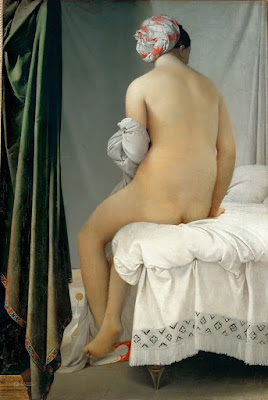 |
| Detail from my current unfinished painting. |
When I go silent about my own work, that means I’m involved in a big mess. My process, as it were, is that I show up in my studio every day at the same time expecting a miracle. More often than not, they happen. But at times nothing works. My painting looks and feels mechanical and rusty.
This is not to say that I don’t know what I’m doing—I haven’t forgotten how to paint. But between the technical and the transcendent, there is slippage that nobody can define. That’s not unique to painting; it’s true of music and (I suspect) a host of other creative endeavors. We sometimes call these things ‘happy accidents,’ but they are more than that. They’re as if the whole universe suddenly slides into place, right there in that tiny rectangle in front of you.
Occasionally, the opposite happens. Nothing comes together. I tap, tap, tap on the frozen parts while nothing moves and I get more aggravated. Those are the weeks I wish I’d taken up something fun, like dentistry.
 |
| Monhegan lobster traps, waiting to trip up the unwary painter. |
What’s got me flummoxed this week is an old nemesis: the lobster trap. A modern lobster trap looks like a plastic-coated
Havahart (®) trap, for you inland dwellers. It operates on the same principle: a lobster unthinkingly (because that’s how lobsters do) crawls up a funnel and gets stuck in the main room. I know how big lobster traps are, what colors they come in, what’s inside them, and how they reflect light. But I don’t seem to be able to paint them convincingly. What’s heartening is that I don’t much like how anyone else paints them, either.
If only Maine lobstermen would use creel-style pots like they do in Scotland! These are rounded, more solid and poetical. But I’m an American, and my paintings ought to be grounded in what is real for my time and place. Darn it.
 |
| I never finished this sketch of lobster traps at Port Clyde, but it’s on my schedule. |
When I’m stuck on something, I revert to first principles. Get closer, look more carefully, and draw, draw, draw. I’ve asked for the loan of a trap, and I’m going to set it up in my studio and study it. (I’d rather not do that in the blowing snow, thanks.) I hope that I have some sort of epiphany that informs my work going into next summer.
 |
| This is the lad who really owned that lobster boat, but I never took a photo of him while I was painting him. |
I’m finishing a painting I started years ago, of Eastport’s lobster fleet. I worked on this for days on the public landing, but it wasn’t finished before I had to leave. The tooth on the canvas is much rougher than I use today. It’s kind of nice, but the adjustment is hard.
Because I took very few photos, I’m forced to make a lot of stuff up. Part of me is certain that a someone will look at this painting and say, “that boat would never have that standing shelter!”
Sadly, I had to lose the figure of the young man who owned the closest boat. He was just too large in my plein air rendering. Since I had no photos of him on his boat, he’s been replaced by a Gloucester fisherman. I’m not sure if that should even be legal.
Meanwhile, I’ll be back tomorrow to tap, tap, tap some more. Eventually it will all fall together. It always does.


























